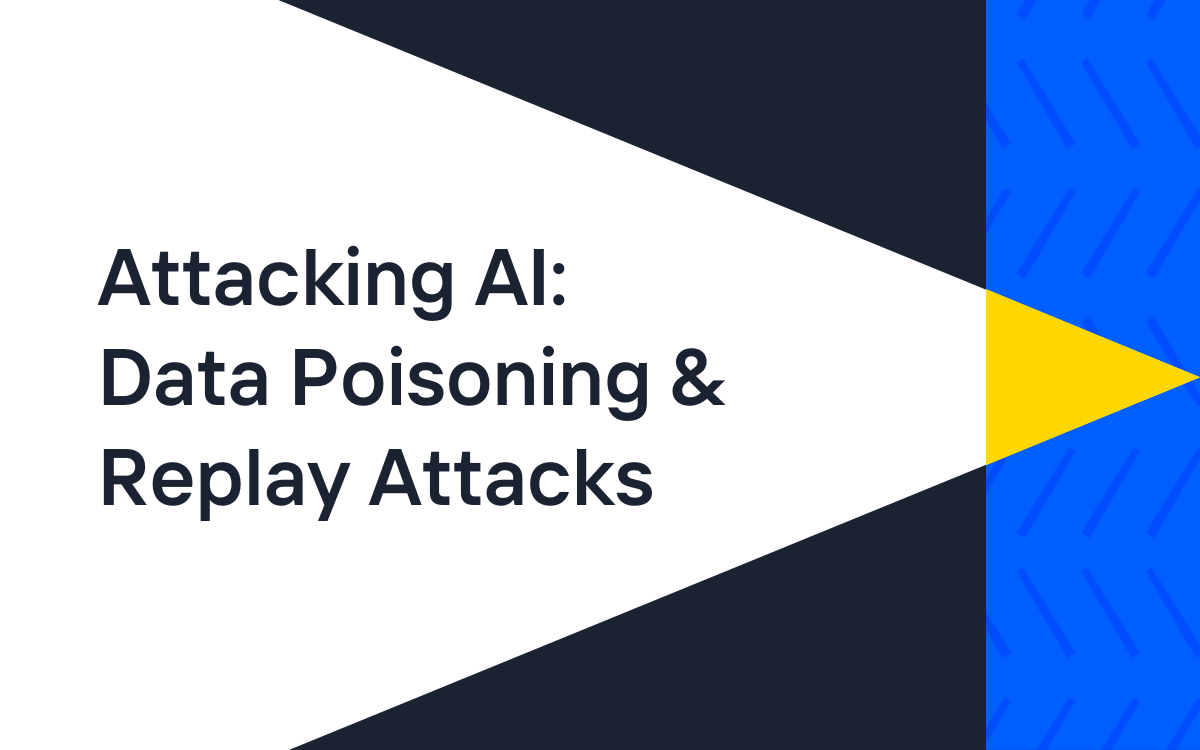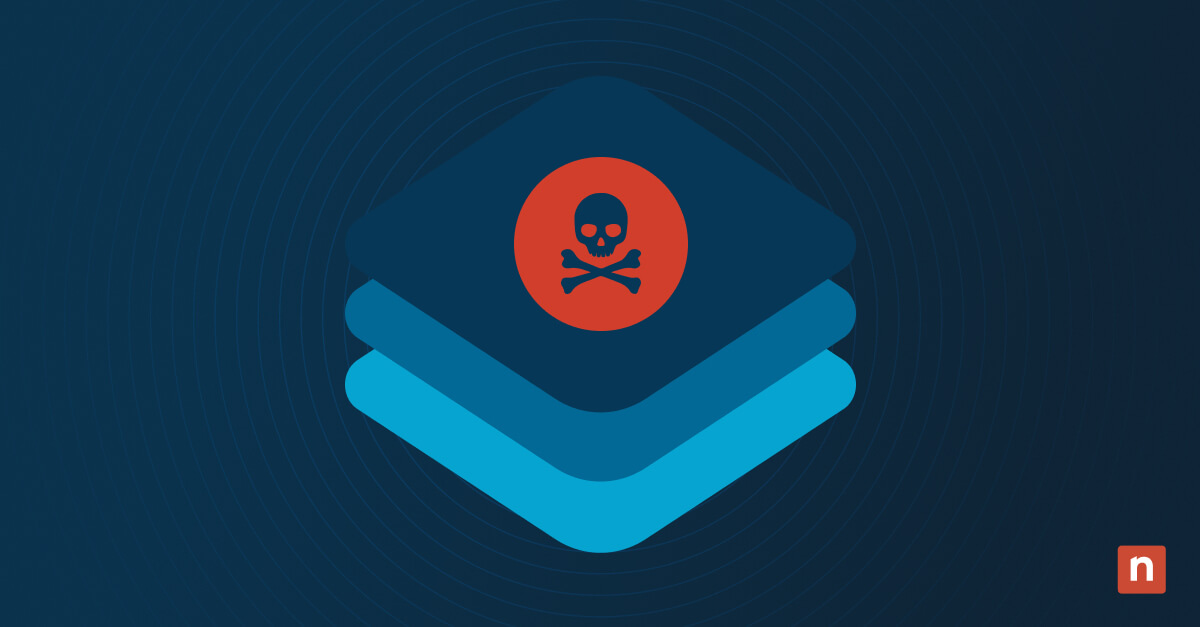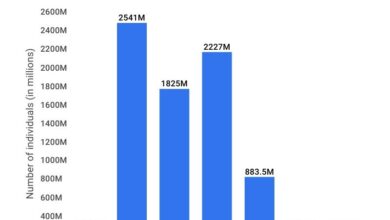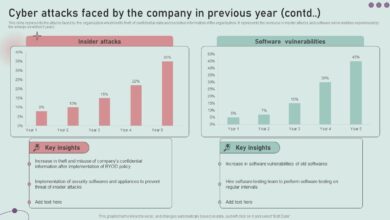
Data Poisoning A Growing Threat to AI and Cybersecurity
Data poisoning a growing threat to cybersecurity and ai datasets – Data poisoning: a growing threat to cybersecurity and AI datasets. It’s a chilling reality – the very data we rely on to power our increasingly intelligent systems is vulnerable to malicious manipulation. Imagine a self-driving car suddenly misinterpreting a stop sign, or a medical diagnosis AI delivering a completely wrong prognosis. These aren’t science fiction scenarios; they’re the potential consequences of data poisoning, a sophisticated attack that subtly corrupts datasets, leading to flawed algorithms and potentially catastrophic outcomes.
This post dives deep into this emerging threat, exploring its methods, defenses, and the crucial role of data provenance in securing our digital future.
From subtle injections of biased data to more overt attacks designed to cripple AI systems, data poisoning is a multifaceted problem. We’ll examine different attack vectors, discuss the vulnerabilities of AI datasets, and explore the crucial role of data provenance and auditing in building resilience against these insidious threats. We’ll also look at real-world examples and explore the latest defense mechanisms being developed to combat this ever-evolving challenge.
Defining Data Poisoning

Data poisoning is a sneaky attack where malicious actors contaminate datasets used to train machine learning models or populate databases. This subtle corruption can have devastating consequences, leading to flawed AI systems and compromised cybersecurity defenses. Understanding the nuances of this threat is crucial for building robust and resilient systems.Data poisoning attacks manipulate the training data, introducing errors or biases that affect the model’s accuracy, reliability, and overall functionality.
The poisoned data can be intentionally crafted to cause specific types of errors, or it might be more subtle, gradually introducing inaccuracies that only become apparent over time. This differs from other attacks, like adversarial examples, which manipulate input data at the time of inference rather than the training phase.
Types of Data Poisoning Attacks
Data poisoning attacks can be broadly categorized based on their methods and objectives. These categories aren’t mutually exclusive; a single attack might exhibit characteristics of multiple types.
Motivations Behind Data Poisoning Attacks
The motivations for launching data poisoning attacks are diverse, ranging from financial gain to disruption and even political influence. For AI systems, attackers might aim to manipulate the output of a model for fraudulent purposes, like manipulating loan applications or medical diagnoses. In cybersecurity contexts, poisoning might be used to compromise intrusion detection systems or create vulnerabilities in security software.
Ultimately, the goal is often to gain an unfair advantage or cause significant harm.
Examples of Real-World Data Poisoning Incidents
Several real-world incidents have demonstrated the devastating potential of data poisoning. While many attacks remain undisclosed for security reasons, the available information highlights the serious nature of this threat. The consequences can range from financial losses to safety risks, impacting various sectors from healthcare to finance.
| Attack Type | Target | Method | Impact |
|---|---|---|---|
| Backdoor Attack | Image Recognition System | Injecting maliciously crafted images into the training dataset, triggering a specific response when a trigger is present in the input image during inference. | Misidentification of objects, leading to potentially dangerous consequences in applications like autonomous driving or security surveillance. |
| Label Flipping | Spam Filter | Changing the labels of legitimate emails to “spam” during the training phase. | Reduced accuracy of the spam filter, leading to legitimate emails being incorrectly flagged as spam, or vice-versa, potentially allowing malicious emails to reach the inbox. |
| Data Injection | Fraud Detection System | Injecting synthetic fraudulent transactions into the training data to create a biased model that fails to detect genuine fraud. | Increased instances of undetected fraud, leading to significant financial losses. |
| Adversarial Examples (during training) | Facial Recognition System | Introducing slightly altered images during training to misclassify certain individuals. | Compromised accuracy of the facial recognition system, potentially leading to identity theft or security breaches. |
Vulnerabilities in AI Datasets
AI datasets, the lifeblood of artificial intelligence, are surprisingly vulnerable to malicious attacks. Their sheer size and complexity, coupled with often-overlooked security measures, create fertile ground for data poisoning, significantly impacting the reliability and accuracy of the AI models they train. Understanding these vulnerabilities is crucial for building more robust and trustworthy AI systems.The inherent vulnerabilities in AI datasets stem from several factors.
Firstly, the process of data collection is often decentralized and lacks rigorous quality control. Data might be sourced from various unreliable or easily manipulated sources, increasing the chances of introducing poisoned data. Secondly, the sheer volume of data in many datasets makes manual inspection and cleaning impractical. This scale makes it difficult to detect subtle manipulations or anomalies indicative of poisoning.
Data poisoning is a serious concern, silently corrupting the foundations of AI and cybersecurity. Building robust systems requires careful attention to data integrity, and that’s where the power of efficient development comes in. Check out this article on domino app dev, the low-code and pro-code future , to see how streamlined development can help us create more secure applications, ultimately mitigating the risks posed by poisoned datasets.
Ultimately, securing our data against these attacks is a crucial step in building a safer digital world.
Finally, a lack of transparency and access control in the data pipelines can allow malicious actors to insert poisoned data unnoticed. These vulnerabilities combine to create a significant threat to the integrity of AI systems.
Challenges in Detecting Poisoned Data
Detecting poisoned data within massive datasets presents significant computational and analytical challenges. Traditional anomaly detection methods often struggle to identify subtle manipulations designed to evade detection. These manipulations might involve only slightly altering existing data points or introducing a small number of carefully crafted poisoned instances. The challenge is further compounded by the inherent noise and variations present in real-world datasets, making it difficult to distinguish between genuine anomalies and intentionally injected poison.
For instance, imagine a dataset for image recognition; a single subtly altered image amongst millions might go unnoticed, yet could significantly bias the model’s classification of similar images. Advanced techniques like adversarial example detection and robust statistical methods are being developed, but they are computationally expensive and may not be effective against sophisticated poisoning attacks.
Impact of Poisoned Data on AI Model Accuracy and Reliability
The consequences of poisoned data on AI models are far-reaching and potentially catastrophic, depending on the application. The impact extends beyond simple inaccuracies; it can lead to unreliable and even harmful outcomes.
- Reduced Accuracy: Poisoned data directly impacts the model’s ability to accurately learn patterns and make correct predictions. This leads to decreased performance and unreliable outputs.
- Biased Predictions: Maliciously injected data can introduce bias into the model, leading to unfair or discriminatory outcomes. For example, a facial recognition system trained on a poisoned dataset could exhibit higher error rates for certain demographics.
- Security Vulnerabilities: In security-sensitive applications, poisoned data can create vulnerabilities, leading to system compromise or malfunction. A poisoned dataset used to train a fraud detection system could lead to undetected fraudulent transactions.
- Erosion of Trust: The discovery of poisoned data in an AI system severely erodes public trust in the reliability and fairness of AI technologies.
Methods of Data Poisoning
Data poisoning, the insidious act of contaminating datasets with malicious entries, is a multifaceted threat. Understanding the various methods employed is crucial for developing robust defenses. These methods can be broadly categorized based on their approach and the specific goals of the attacker. The effectiveness of each technique varies depending on factors like the size of the dataset, the sophistication of the poisoning strategy, and the robustness of the machine learning model being targeted.
Backdoor Attacks
Backdoor attacks aim to introduce a hidden vulnerability into a machine learning model. The poisoned data subtly influences the model’s behavior, causing it to produce a specific, incorrect output when presented with a particular trigger. This trigger can be a seemingly innocuous feature or a carefully crafted input. The attacker’s goal is to maintain the model’s overall accuracy on clean data while secretly controlling its output under specific conditions.
- Trigger-based poisoning: This involves adding data points that contain a specific trigger (e.g., a watermark added to an image) that forces the model to misclassify when that trigger is present. For example, an attacker might add images of cats with a subtle watermark, training the model to misclassify them as dogs when the watermark is present, while maintaining accuracy on clean cat images.
- Clean-label poisoning: This technique manipulates the labels of existing data points without changing the features. The attacker might change the label of a benign image to something malicious, gradually influencing the model’s decision boundaries.
- Data augmentation attacks: This involves subtly altering existing data points in the training set. For instance, an attacker could slightly modify existing images to include a backdoor trigger while keeping them visually similar to the original data. This makes the attack harder to detect.
Adversarial Examples
Adversarial examples are carefully crafted inputs designed to fool a machine learning model. These examples are often very close to legitimate data points but cause the model to make a specific incorrect prediction. The subtlety of these attacks makes them particularly challenging to detect and defend against.
- Fast Gradient Sign Method (FGSM): This method adds a small perturbation to the input data, calculated based on the gradient of the loss function. This perturbation is designed to maximize the model’s error. For instance, a small change to the pixels of an image could be sufficient to change its classification.
- Projected Gradient Descent (PGD): This is an iterative approach that refines the perturbation over multiple steps, resulting in more effective adversarial examples than FGSM. It’s more computationally expensive but often produces stronger attacks.
- Carlini and Wagner (C&W) attack: This attack uses a more sophisticated optimization technique to find adversarial examples that are less perceptible to humans while still causing significant misclassification. This method often leads to more robust adversarial examples compared to FGSM or PGD.
Targeted Poisoning
Targeted poisoning aims to corrupt the model’s performance for a specific set of inputs or a specific class of data. The attacker might focus on manipulating the model’s behavior for a particular target user, product, or category.
- Label flipping: This involves changing the labels of specific data points to force the model to misclassify those data points. For example, an attacker might flip the labels of all images belonging to a particular class, leading to a significant drop in accuracy for that class.
- Feature manipulation: This involves altering specific features within the data points. This could be achieved by modifying the values of specific attributes, adding noise, or injecting specific patterns into the data.
Defense Mechanisms Against Data Poisoning
Data poisoning, the malicious contamination of datasets, poses a significant threat to the reliability and security of AI systems. Fortunately, several defense mechanisms can be implemented to mitigate this risk, bolstering the integrity of datasets and the AI models trained upon them. These defenses range from proactive measures aimed at preventing poisoning to reactive techniques designed to detect and remediate poisoned data.Robust defense strategies require a multi-layered approach, combining various techniques to create a comprehensive safeguard.
This involves careful data validation, rigorous anomaly detection, and the implementation of robust data sanitization procedures. Each layer contributes to minimizing the impact of potential poisoning attempts.
Anomaly Detection Techniques
Identifying anomalies within a dataset is crucial for detecting potential data poisoning. Anomalies represent data points that deviate significantly from the expected pattern or distribution. Several statistical and machine learning methods can be employed. For example, techniques like outlier detection using algorithms such as Isolation Forest or One-Class SVM can flag data points that are statistically improbable given the rest of the dataset.
Another approach involves monitoring data distributions over time; significant shifts in the mean, variance, or other statistical properties might indicate poisoning. Imagine a dataset tracking customer spending habits: a sudden surge in unusually high transactions from a single IP address might be a red flag. Similarly, monitoring the distribution of feature values can reveal anomalies. If a particular feature suddenly shows a dramatic shift in its distribution, this may indicate that data points have been manipulated.
Data Validation and Sanitization Processes
Data validation and sanitization are crucial steps in preventing data poisoning. Data validation ensures that incoming data conforms to predefined rules and constraints. This might involve checking data types, ranges, and formats. For instance, a validation rule might specify that age values must be positive integers within a reasonable range. Data that fails validation is rejected or flagged for further investigation.
Sanitization, on the other hand, involves cleaning and transforming data to remove or mitigate potentially harmful elements. This could include removing outliers identified by anomaly detection, handling missing values using imputation techniques, or transforming data to reduce its susceptibility to adversarial attacks. For example, techniques like data normalization or standardization can reduce the impact of outliers and make the data less sensitive to manipulation.
Consider a scenario where a malicious actor attempts to inject fake reviews into a product rating system. Data validation could check for inconsistencies in user IDs, timestamps, or review text, flagging suspicious entries for manual review or automated rejection. Sanitization might involve removing or modifying entries that violate predefined rules or are flagged as suspicious.
The Role of Data Provenance and Auditing

Data poisoning attacks, as we’ve explored, can severely compromise the integrity and reliability of AI systems. A crucial line of defense against these attacks lies in meticulously tracking the origin and history of data – its provenance – and implementing robust auditing mechanisms. Without a clear understanding of where data comes from and how it has been handled, detecting and responding to malicious manipulation becomes exponentially more difficult.Maintaining detailed records of data provenance is paramount for enhancing data security.
This involves documenting the entire lifecycle of a data point, from its initial creation or acquisition, through all processing and transformation steps, to its final use in an AI model. This comprehensive record allows us to trace back any anomalies or inconsistencies to their source, potentially identifying malicious actors or accidental errors. For example, if a poisoned data point causes unexpected model behavior, tracing its provenance can reveal the point of contamination and help prevent similar incidents in the future.
Data Provenance Implementation
Effective data provenance implementation requires a multi-faceted approach. This includes assigning unique identifiers to each data point, meticulously documenting all transformations applied to the data, and maintaining a secure and auditable log of all data access and modifications. This granular level of tracking enables precise identification of the source of any discrepancies or inconsistencies, pinpointing the exact stage where manipulation may have occurred.
Blockchain technology, with its immutable record-keeping capabilities, is increasingly being explored as a promising solution for maintaining secure and tamper-proof data provenance records. Furthermore, cryptographic hashing techniques can be used to verify the integrity of data at each stage of its lifecycle.
Data Auditing Mechanisms
Data auditing mechanisms play a critical role in detecting and preventing data manipulation. These mechanisms involve regularly inspecting data for inconsistencies, anomalies, and signs of tampering. Statistical analysis can be used to identify unusual patterns or outliers that might indicate the presence of poisoned data. For example, sudden shifts in data distributions or unexpected correlations between variables can be red flags.
Machine learning algorithms can also be employed to detect anomalies, by training models on known “good” data and flagging instances that deviate significantly from the established patterns. Regular audits, combined with robust anomaly detection techniques, form a powerful defense against data poisoning attacks.
A Robust Data Provenance and Auditing System
The following flowchart illustrates the steps involved in a robust data provenance and auditing system:[Imagine a flowchart here. The flowchart would begin with “Data Ingestion,” showing data entering the system and being assigned unique identifiers. The next step would be “Data Processing,” illustrating various transformations and processing steps, with each step meticulously logged. This would be followed by “Data Storage,” showing secure storage of both the data and its provenance metadata.
Then, “Data Auditing” would be depicted, showing the process of regularly analyzing the data and its provenance for anomalies and inconsistencies. Finally, “Anomaly Detection and Response” would show the process of identifying and responding to any detected anomalies, including investigation and remediation.] The system would loop back to Data Processing after each audit to allow for iterative improvement and refinement of the data pipeline based on audit findings.
This cyclical approach allows for continuous monitoring and improvement of the data security and integrity.
Future Threats and Challenges
Data poisoning, while currently a significant concern, is poised to evolve in complexity and scale, mirroring the advancements in AI and the increasing reliance on data-driven systems. The future landscape of data poisoning presents several formidable challenges, demanding proactive and innovative defense strategies. Understanding these emerging threats is crucial for building robust and resilient AI systems.The increasing sophistication of AI techniques will inevitably impact both the creation and detection of data poisoning attacks.
Advanced generative models, for instance, could be leveraged to create highly realistic and undetectable poisoned data points, making it increasingly difficult to distinguish them from legitimate data. Conversely, advanced AI can also be employed to develop more sophisticated detection mechanisms, leading to an arms race between attackers and defenders. This continuous evolution necessitates a dynamic approach to security, adapting to the ever-changing threat landscape.
The Rise of Adversarial Attacks
The use of adversarial attacks, designed to specifically target and manipulate AI models, represents a significant escalation in data poisoning. These attacks go beyond simply injecting bad data; they craft malicious inputs intended to cause the AI model to misbehave in predictable ways. For example, a seemingly innocuous image slightly altered using an adversarial attack could cause a self-driving car’s AI to misinterpret a stop sign.
The challenge lies in developing robust defenses that can withstand these highly targeted and subtle manipulations. These attacks often require a deep understanding of the underlying AI model’s architecture and training process.
The Impact of Federated Learning
Federated learning, a technique allowing AI models to be trained on decentralized data without direct data sharing, introduces new vulnerabilities to data poisoning. While offering privacy advantages, it also creates opportunities for malicious actors to poison data at the individual device level. Detecting and mitigating such attacks becomes significantly more challenging due to the distributed nature of the training process.
The lack of centralized data visibility makes traditional detection methods less effective, demanding new approaches focused on anomaly detection within the distributed training process itself. A real-world example could involve a malicious app participating in a federated learning system for medical diagnosis, subtly injecting biased data to skew the model’s predictions.
The Need for Collaboration and Standardization
Effective countermeasures against data poisoning require a collaborative effort across academia, industry, and government. Standardization of data provenance tracking, auditing procedures, and defense techniques is crucial for creating a more secure ecosystem. Sharing best practices and openly discussing vulnerabilities will accelerate the development of effective defenses and foster a more resilient AI landscape. The absence of widely adopted standards makes it difficult to compare and evaluate different defense mechanisms, hindering progress in the field.
Comparison of Defense Strategies
| Strategy | Strengths | Weaknesses | Applicability |
|---|---|---|---|
| Robust Statistical Methods | Relatively simple to implement; can detect some types of poisoning. | Can be easily bypassed by sophisticated attacks; may produce false positives. | Broad applicability, but effectiveness varies depending on the attack. |
| Adversarial Training | Improves model robustness against adversarial examples. | Computationally expensive; may not be effective against all types of attacks. | Suitable for applications where model robustness is paramount. |
| Data Provenance Tracking | Allows for tracing data origins and identifying potential sources of poisoning. | Requires significant infrastructure and data management overhead. | Most effective when implemented from the data acquisition stage. |
| Blockchain-based Data Management | Provides immutability and transparency, enhancing data integrity. | Scalability challenges; can be complex to implement. | Suitable for applications requiring high levels of trust and security. |
Illustrative Example: A Poisoned Image Dataset
Imagine a scenario where a self-driving car company, “AutoDrive,” is developing an object recognition AI to enhance its autonomous vehicles’ safety features. They train their AI using a massive image dataset sourced from various public and private contributors. This dataset includes images of pedestrians, vehicles, traffic signs, and other relevant objects. Unbeknownst to AutoDrive, a malicious actor has subtly poisoned a portion of this dataset.This malicious actor, let’s call them “MaliciousAI,” aims to compromise the safety of AutoDrive’s vehicles.
Their method involves carefully crafting a subset of images depicting stop signs. In these poisoned images, MaliciousAI subtly alters the stop signs – perhaps by adding a barely perceptible overlay or slightly changing the color – making them appear as speed limit signs to the human eye, but causing the AI to misclassify them. The alterations are subtle enough to evade casual inspection but significant enough to confuse the AI’s training process.
Poisoning Method and Impact, Data poisoning a growing threat to cybersecurity and ai datasets
MaliciousAI uses a “backdoor” poisoning technique. They strategically inject these subtly altered stop sign images into the training dataset, ensuring they are a small but statistically significant portion of the total data. The sheer volume of the dataset makes detecting these anomalies extremely difficult. The result is an AI model that, while performing well on most images, consistently misidentifies subtly altered stop signs as speed limit signs.
This could have catastrophic consequences, as a self-driving car might fail to stop at a stop sign, leading to accidents. The impact is not immediate or obvious; the AI’s overall accuracy might remain high, masking the insidious nature of the poisoned data.
Detection Challenges
Detecting this type of poisoning presents significant challenges. Traditional methods that focus on overall accuracy might miss the subtle bias introduced by the poisoned images. Furthermore, identifying the specific poisoned images requires sophisticated anomaly detection techniques that can differentiate between genuine variations in image data and the malicious alterations. The subtle nature of the changes makes it difficult for standard quality control checks to identify the problem.
Moreover, the sheer size of the dataset makes manual inspection impractical. AutoDrive would likely need to employ advanced anomaly detection algorithms and potentially conduct a thorough analysis of the data’s provenance to uncover the malicious manipulation. This illustrates the difficulty in ensuring the trustworthiness of AI models trained on large, externally sourced datasets.
Illustrative Example: A Poisoned Text Dataset: Data Poisoning A Growing Threat To Cybersecurity And Ai Datasets
Imagine a scenario where a large language model (LLM) is being trained to perform sentiment analysis on customer reviews for a major online retailer. The goal is to accurately classify reviews as positive, negative, or neutral to understand customer opinions about products and services. A malicious actor, perhaps a competitor, seeks to manipulate the training data to negatively impact the retailer’s AI system.This malicious actor injects subtly poisoned reviews into the dataset.
Instead of overtly negative reviews, they use a more sophisticated approach. They craft reviews that are grammatically correct, superficially positive, but contain carefully embedded negative sentiment expressed through subtle word choices, sarcasm, or ironic phrasing. For instance, a review might say, “The product arrived on time, which was a pleasant surprise! The packaging was also quite impressive, though the actual product itself was… underwhelming, to say the least.” The seemingly positive opening masks the underlying negative sentiment.
This approach makes detection more challenging because the reviews don’t stand out as obviously fake or malicious.
Poisoning Method and Impact, Data poisoning a growing threat to cybersecurity and ai datasets
The poisoning method employed is a form of “backdoor attack,” where the attacker inserts carefully crafted adversarial examples. These examples are designed to trigger a specific, incorrect output from the sentiment analysis model, regardless of the actual sentiment expressed. In this case, the goal might be to consistently misclassify genuinely positive reviews as negative or neutral, thereby artificially lowering the retailer’s apparent customer satisfaction scores.
This could negatively affect the retailer’s business decisions, from product development to marketing strategies. The impact on the AI’s performance would manifest as a significant drop in accuracy, particularly for reviews containing similar subtle negative phrasing to the poisoned data. The model would learn to associate certain seemingly positive phrases with negative sentiment, leading to misclassifications on unseen data.
Detection Challenges
Detecting this type of poisoning presents significant challenges. Traditional methods of detecting outliers or anomalous data points might not be effective because the poisoned reviews appear superficially normal. Statistical anomaly detection techniques may fail to flag them as unusual. Furthermore, the subtle nature of the poisoning makes it difficult for human reviewers to identify the malicious content, as they might miss the carefully concealed negative sentiment.
Sophisticated techniques, such as adversarial training and robust model architectures, might be necessary to detect and mitigate the impact of this type of data poisoning. A comprehensive data provenance and auditing system, capable of tracing the origin and history of each data point, would also greatly aid in identifying suspicious entries.
Last Point

Data poisoning is no longer a theoretical threat; it’s a present-day reality demanding immediate attention. The increasing reliance on AI and the sheer volume of data being generated necessitate a proactive approach to data security. By understanding the methods of attack, implementing robust defense mechanisms, and prioritizing data provenance and auditing, we can significantly mitigate the risks and build more secure and trustworthy AI systems.
The fight against data poisoning is a continuous process, requiring collaboration, innovation, and a commitment to building a more resilient digital world. The stakes are high, but with a proactive and collaborative approach, we can build a future where AI serves humanity safely and reliably.
User Queries
What are the long-term consequences of unchecked data poisoning?
Unmitigated data poisoning could lead to widespread erosion of trust in AI systems, hindering their adoption in critical sectors like healthcare and finance. It could also result in significant financial losses, reputational damage for organizations, and even physical harm in scenarios involving autonomous systems.
Can data poisoning affect non-AI systems?
Yes, data poisoning can affect any system that relies on data for decision-making. While AI systems are particularly vulnerable due to their reliance on vast datasets, traditional systems can also be compromised by poisoned data, leading to inaccurate reporting, flawed analysis, and poor decision-making.
How can individuals contribute to mitigating data poisoning?
Individuals can contribute by promoting awareness of data poisoning, supporting research into detection and prevention methods, and practicing good data hygiene, such as being critical of information sources and reporting suspicious activities.
Is there a single solution to prevent all data poisoning attacks?
No, there’s no single silver bullet. A multi-layered approach combining robust data validation, provenance tracking, anomaly detection, and regular auditing is necessary to effectively combat data poisoning.





